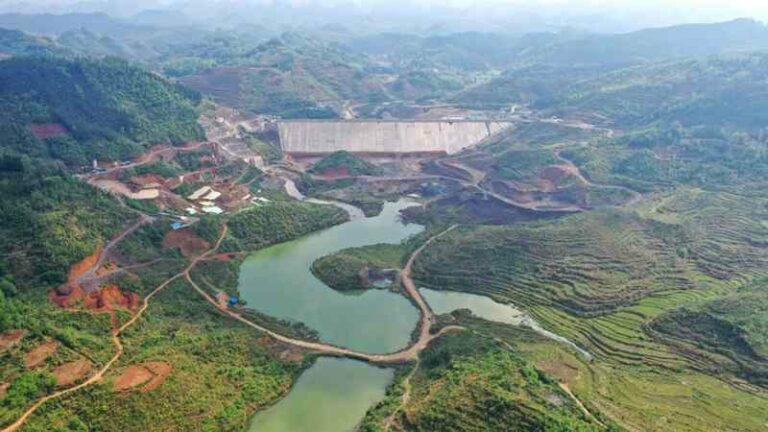
By Huang Xian, People’s Daily
“Now that we can get water whenever we want, it becomes so much easier for us to grow sweet potatoes and make sweet potato noodles,” Dai Zefei, a villager in southwest China’s Guizhou province, told People’s Daily while making sweet potato noodles.
“Good natural environment and water quality guarantee high-quality sweet potatoes. My homemade noodles have a wonderful taste. I get too many orders to fill now,” Dai said proudly.
Dai lives in a mountainous village in Yinjiang Tujia and Miao autonomous county, Tongren City, Guizhou province, where serious water scarcity used to be a major headache plaguing local people.
Located in the karst mountains, Guizhou has faced great difficulty storing and channeling water because of the complex geographical conditions.
In recent years, the province has continuously improved its infrastructure for drinking water and irrigation, among other purposes, and accelerated the construction of large reservoirs in rural areas.
By the end of 2021, the designed water supply capacity of water conservancy projects across the province has reached 13.2 billion cubic meters, which preliminarily solved the problem of water shortage due to the lack of water supply projects.
Today, every county of Guizhou has a medium-sized reservoir, and every township in the province enjoys a stable water supply.
In April this year, a newly built reservoir on Qingdu River in Yinjiang Tujia and Miao autonomous county officially began storing water, guaranteeing a steady supply of clean drinking water for more than 20,000 people, and sufficient irrigation water for about 20,000 mu (about 1,333 hectares) of farmlands in the surrounding areas. Dai is one of the residents who have benefited from the reservoir.
Besides building reservoirs to guarantee stable water sources, the province has also built a water supply pipeline network to make tap water accessible for local people in their homes.
Over the past nearly five years, Guizhou has spent 165.8 billion yuan (about $24.67 billion) on water conservancy projects and kicked off the construction of 300 key projects for water supply, increasing tap-water coverage in rural areas to 90.4 percent and bringing safe drinking water to 21.31 million rural residents.
“We used to drink mountain spring water and rainwater running off the roof. On rainy days, the water would become so muddy that we had to keep it in a cistern for a couple of days to let the impurities subside before we can drink it. The tap water we drink now has a sweet taste. Even the rice cooked with the water tastes better than before,” said villager Yang Chengjiang.
“Now that we have ponds in our village and irrigation pipes that help transfer clean water to the mountains, I can expect better yield from my cherry trees,” said Yang Caimao, a cherry grower in Shedongguan Yi, Miao, and Bai ethnic township, Nayong county, Bijie city of Guizhou province.
Since cherry orchards are mostly located on hillsides, watering the fruit trees used to be a tough task for local farmers. Thanks to the improvement in local irrigation conditions, Yang’s cherry trees have been well watered and produced a good harvest, bringing him an income of more than 100,000 yuan (about $14,863) this year.
The improvement in local irrigation conditions is attributed to a pilot project launched in rural areas of Guizhou, including the township, to build modern water conservancy facilities.
“Impounding reservoirs, water pumping pipes, as well as main and branch pipes, formed an irrigation network for mountainous areas of the township, effectively guaranteeing water supply for 1,650 mu (110 hectares) of cherry orchards,” said Meng Wenyi, a team leader in the project.
As it has become more and more convenient for locals to use water, the water environment in Guizhou has also been improved.
In Longshan township, Longli County, Qiannan Buyi, and Miao autonomous prefecture of Guizhou province, residents have been gratified by the significant improvement in the water quality of the Duohua river that flows around villages.
“We couldn’t have embraced a happy life without a good water environment. Since the river near our homes has become clear and beautiful, there are so many possibilities we can explore for increasing our incomes, such as green industries and agritainment business,” said Wang Delin, a villager in Longshan township.
Duohua river was once a smelly ditch because of the disorderly discharge of sewage and waste. In 2020, Longli county became one of the first counties selected for the country’s pilot project for enhancing water system connectivity and improving the water environment in rural areas.
The project launched for comprehensive treatment and improvement of river systems, which involved a total investment of 455 million yuan ($67.63 million), has systematically restored the river systems in rural areas of Longli county.
It’s believed that more rural areas in the country will enjoy a good water environment and offer residents a better living environment.
In recent years, China has earnestly advanced the construction of water infrastructure in rural areas. In 2021, the tap-water coverage in China’s rural areas reached a record high of 84 percent, according to data from the country’s Ministry of Water Resources.
In the same year, the country repaired and maintained 99,000 water supply projects and harnessed more than 3,800 kilometers of rivers and over 1,300 lakes and ponds in rural areas, significantly improving the ecological environment of rivers and lakes and benefiting more than 3,300 villages.










